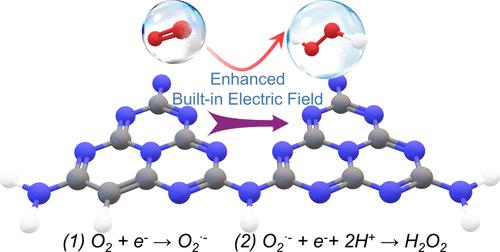Boosting Solar-to-H2O2 by Molecularly Tunable Heterostructured Pym-CN with an Enhanced Built-In Electric Field
IF 13.1
1区 化学
Q1 CHEMISTRY, PHYSICAL
引用次数: 0
Abstract
Utilizing photocatalytic technology to achieve efficient production of H2O2 is a hot topic. Here, we synthesized a photocatalytic material with a strong built-in electric field, namely, Pym-CN, through a hydrothermal-assisted thermal polymerization strategy, which effectively promotes the separation and transfer of photoinduced charge carriers. A pyrimidine ring was successfully introduced into the heptazine structure unit of Pym-CN, which leads to electron aggregation at N═C–N, benefiting for enhancing the strong sorption and activation capabilities of oxygen. Under the condition of visible light wavelength greater than 400 nm (λ > 400 nm), the H2O2 production rate of Pym-CN (2622.5 μmol/L/h) is 7.6 times that of the BCN. A detailed investigation of the reaction mechanism revealed that Pym-CN follows a two-step continuous process of single-electron oxygen reduction reaction (ORR). This work elucidates the application prospects of the donor–acceptor (D–A) structure with a strong built-in electric field in the field of efficient photocatalytic production of H2O2.

具有增强内置电场的分子可调谐异质结构 Pym-CN 推动太阳能转化为二氧化氢
利用光催化技术实现 H2O2 的高效生产是一个热门话题。在此,我们通过水热辅助热聚合策略合成了一种内置强电场的光催化材料,即 Pym-CN,它能有效促进光诱导电荷载流子的分离和转移。在 Pym-CN 的庚嗪结构单元中成功引入了嘧啶环,使电子聚集在 N═C-N,有利于增强对氧气的吸附和活化能力。在可见光波长大于 400 nm(λ > 400 nm)的条件下,Pym-CN 的 H2O2 生成速率(2622.5 μmol/L/h)是 BCN 的 7.6 倍。对反应机理的详细研究表明,Pym-CN 遵循的是单电子氧还原反应(ORR)的两步连续过程。这项工作阐明了内置强电场的供体-受体(D-A)结构在高效光催化产生 H2O2 领域的应用前景。
本文章由计算机程序翻译,如有差异,请以英文原文为准。
求助全文
约1分钟内获得全文
求助全文
来源期刊

ACS Catalysis
CHEMISTRY, PHYSICAL-
CiteScore
20.80
自引率
6.20%
发文量
1253
审稿时长
1.5 months
期刊介绍:
ACS Catalysis is an esteemed journal that publishes original research in the fields of heterogeneous catalysis, molecular catalysis, and biocatalysis. It offers broad coverage across diverse areas such as life sciences, organometallics and synthesis, photochemistry and electrochemistry, drug discovery and synthesis, materials science, environmental protection, polymer discovery and synthesis, and energy and fuels.
The scope of the journal is to showcase innovative work in various aspects of catalysis. This includes new reactions and novel synthetic approaches utilizing known catalysts, the discovery or modification of new catalysts, elucidation of catalytic mechanisms through cutting-edge investigations, practical enhancements of existing processes, as well as conceptual advances in the field. Contributions to ACS Catalysis can encompass both experimental and theoretical research focused on catalytic molecules, macromolecules, and materials that exhibit catalytic turnover.
文献相关原料
公司名称
产品信息
麦克林
Potassium titanium oxalate
麦克林
Sodium sulfate
阿拉丁
Melamine
阿拉丁
Cyanuric acid
阿拉丁
2,4,6-triaminopyrimidine
阿拉丁
Ethylenediaminetetraacetic acid
阿拉丁
Nitrotetrazolium blue chloride
 求助内容:
求助内容: 应助结果提醒方式:
应助结果提醒方式:


